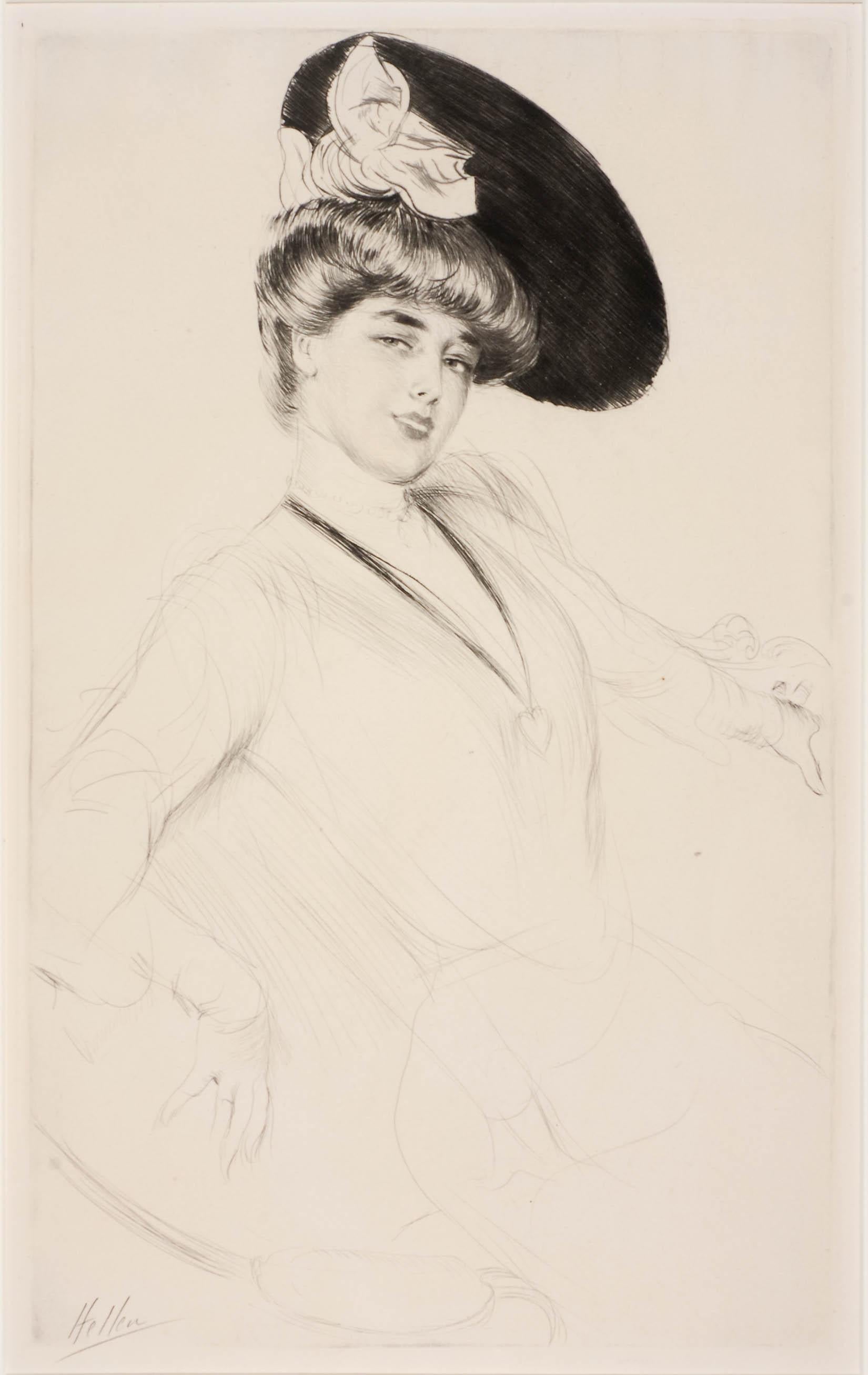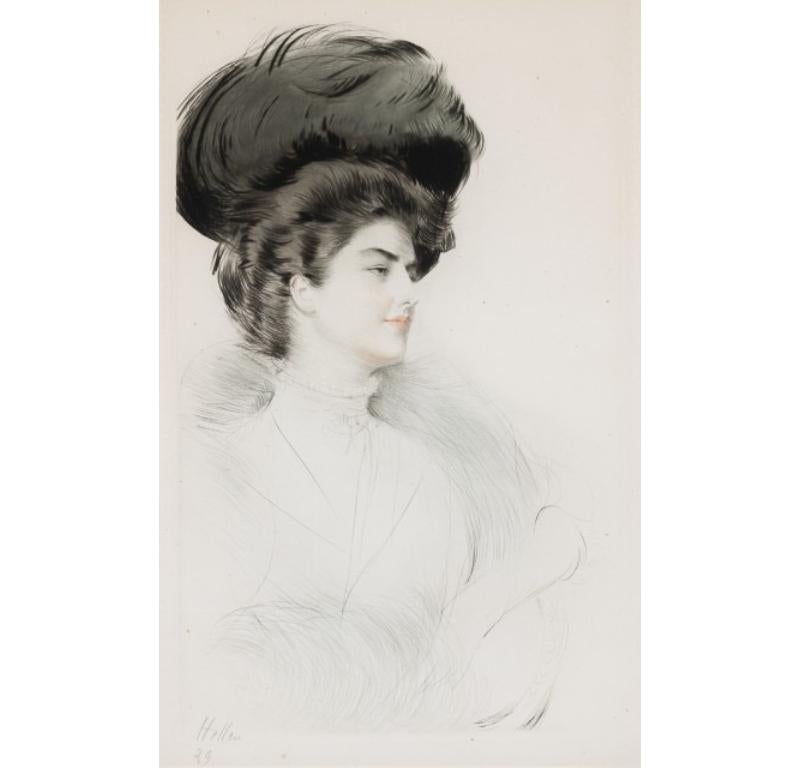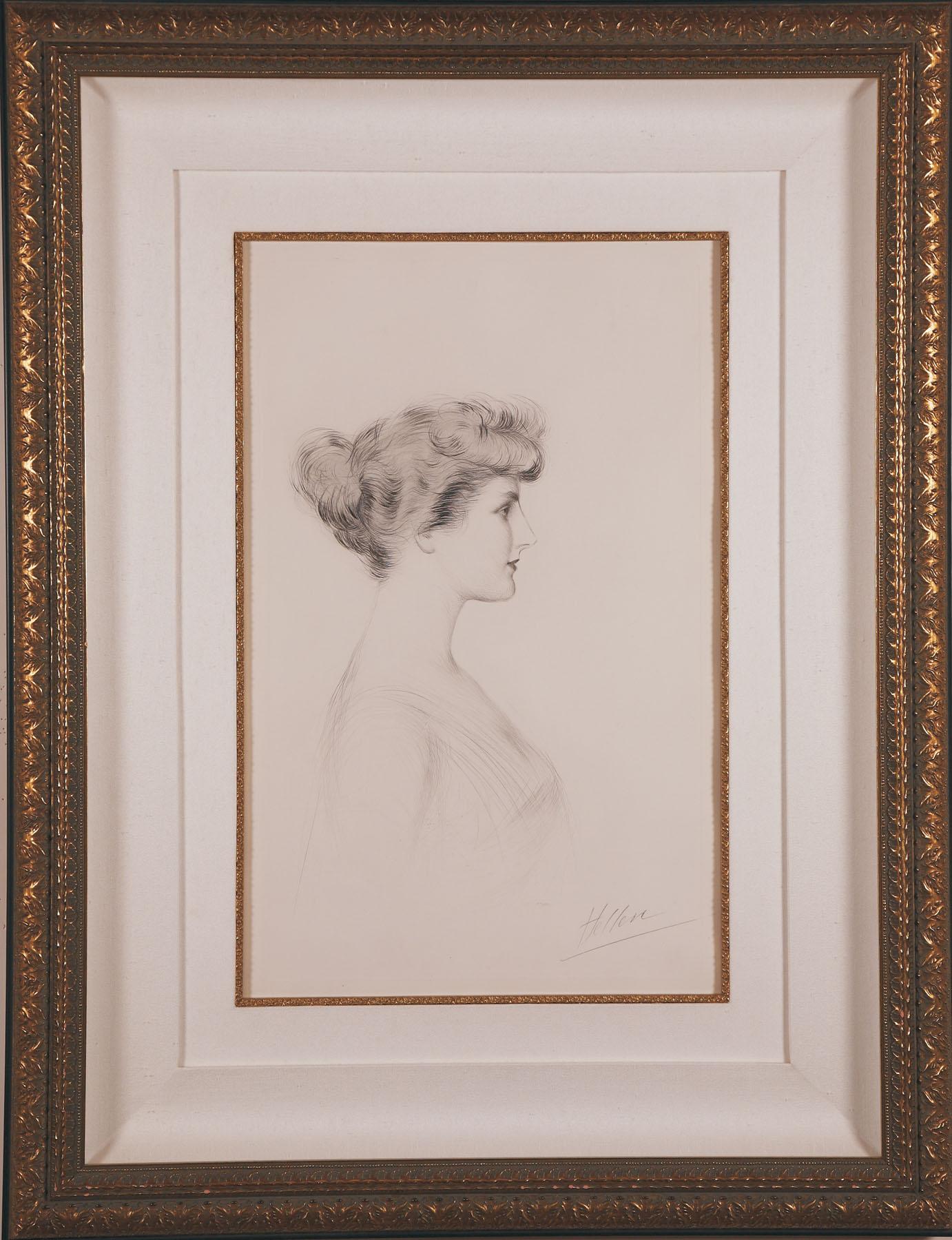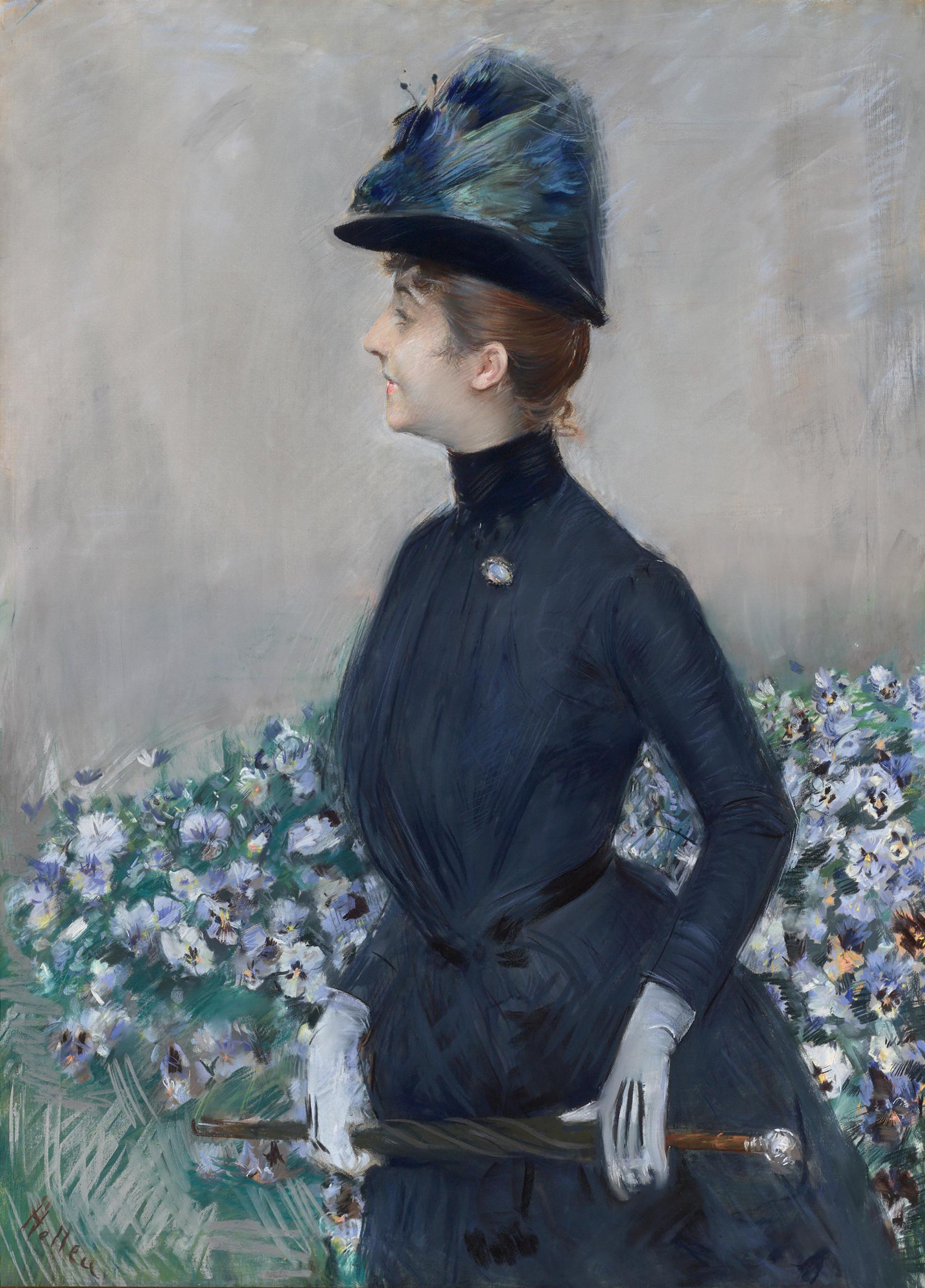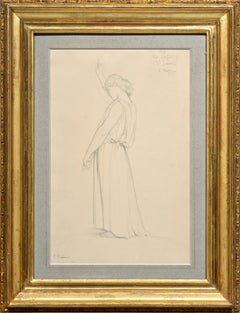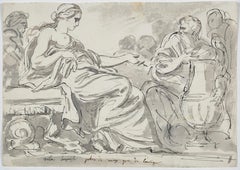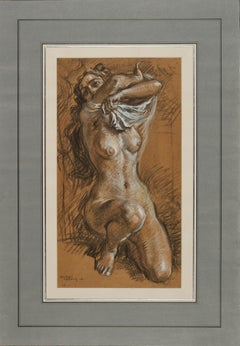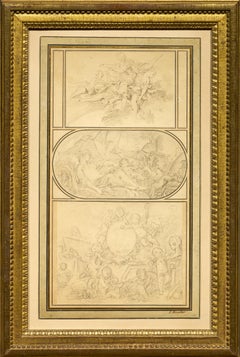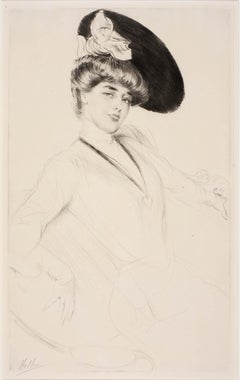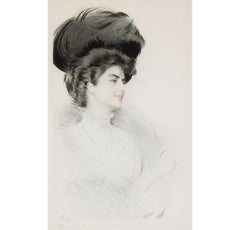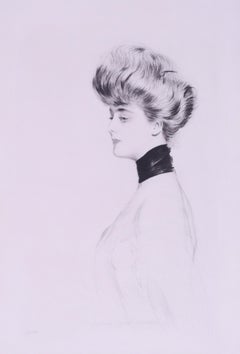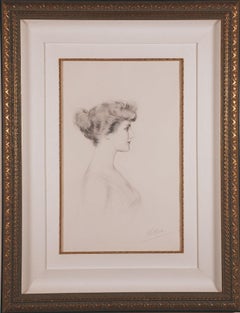Items Similar to A circular dish decorated by Paul Helleu with a Portrait of a Woman
Want more images or videos?
Request additional images or videos from the seller
1 of 7
Paul HelleuA circular dish decorated by Paul Helleu with a Portrait of a Woman1882 - 1887
1882 - 1887
$5,352.17
£3,986.13
€4,500
CA$7,506.69
A$8,234.11
CHF 4,246.02
MX$98,348.27
NOK 53,852.47
SEK 50,519.73
DKK 34,300.99
About the Item
This dish, inspired by the bellas of the Italian Renaissance, bears witness to the fruitful collaboration that began in 1882 between the ceramist Théodore Deck and the young artist Paul Helleu, before the latter became the fashionable portraitist of feminine elegance.
1. Paul Helleu
In 1913 Robert de Montesquiou wrote in his book devoted to the painter: "Helleu was born in Vannes in 1859, of a Breton father and a Parisian mother". He hardly knew his father, who died when he was three years old, and was brought up entirely by his mother, who sent him to continue his studies at the Lycée Chaptal in Paris in 1873.
The discovery of Edouard Manet's Chemin de Fer at the 1874 Salon is reported to be at the origin of his artistic vocation. He worked against his mother's wishes in the studio of the painter Gérôme, also frequented by the painters Giovanni Boldini, Jean-Louis Forain and Antonio de La Gandara. Helleu became friends with John Singer Sargent, with whom he shared a studio for some time, as well as with Claude Monet (1840 - 1926) and Jacques Blanche (1861 - 1942), who accompanied him on a trip to England during which he met the painters Whistler and James Tissot.
When his mother cut off his pension to divert him from painting, Helleu worked in the workshop of the ceramist Théodore Deck, where he decorated ornamental ceramic medallions with women’s faces to pay for his studies at the Paris School of Fine Arts.
In 1884, the Louis-Guérin household commissioned him to paint a portrait of their daughter Alice, aged 14, which was to appear in the Salon of 1885 . Helleu fell madly in love with his model and wished to marry her. Her parents agreed to the wedding subject to three conditions: that it should only take place when Alice turned 16 (!), that she should finish her studies and that the newlyweds should live with them for two years.
From 1886 onwards, a series of happy events and successes followed: his marriage, followed by the birth of his first daughter Ellen in 1887, the participation in the Pastelists' Salon and the first exhibition of his drypoints in New York in 1889. His friendship with Robert de Montesquiou, whom he met in 1887, opened him the doors of the Parisian aristocracy. In 1891 he painted a series of portraits of Montesquiou’s cousin, the Countess Greffulhe, before meeting Marcel Proust in 1895, also thanks to Montesquiou. Proust took much of his inspiration from Helleu for the character of the painter Elstir in A la Recherche du Temps Perdu, a character whose name is said to be a clever alchemy between the names of Helleu and Whistler.
Helleu by then was at the peak of his art and multiplied female portraits, alternating between drypoint, pastels, three-colour pencil drawings whose technique had been inspired by Watteau's, and oil paintings. Commissions for his women’s portraits came from the Parisian High Society as well as from England and the United States, allowing the painter to choose his models.
The First World War dealt a fatal blow to the world in which Helleu had been one of the most emblematic portraitists. His activity during and after the war was greatly reduced, while he was unable to reinvent his art to seduce a new public. Helleu died on March 23rd 1927 after having seen those who had counted most in his life pass away: Montesquiou in 1921, Proust in 1922, Sargent in 1925 and finally Monet in 1926.
2. Théodore Deck and his collaboration with Helleu
The son of a silk dyer from Guebwiller, Théodore Deck joined the master potter Hügelin in Strasbourg in 1841 and arrived in Paris in 1847, after a long journey in Germany, Austria and Hungary. In December 1851 he was hired as a foreman by the widow Dumas, daughter of the potter Vogt, for whom he had worked on his arrival in Paris. In 1858, together with his brother, he created a company specialising in stove linings. The success of their business enabled them to quickly move into ceramics for building cladding and shaped pieces.
The Deck brothers often called on artists to decorate dishes, tiles or plates, dividing the proceeds of the sale into two equal parts. Thus in 1882 Paul Helleu, deprived of his mother's subsidies, began a collaboration that would probably last at least until his marriage in 1886, or even (according to the painter Blanche) for about ten years.
The pieces we have been able to find (the online catalogue raisonné of Helleu's ceramic work is not yet available) generally represent busts of women standing out against a brightly coloured background. The costumes are often inspired by the Renaissance, and it seems to us that these pieces are a distant echo of the bellas made by Italian faience makers during the Renaissance (5th photo of the gallery.
In 1887, Théodore Deck became director of the Manufacture Nationale de Sèvres and left his brother in charge of the company, which collapsed and closed a few years after his death in 1891.
3. Description of the artwork
As is often the case with this type of commission, it is likely that Helleu was inspired by a photography to paint this elegant young woman, dressed in the latest fashion. The black background highlights the fabric flower adorning her hair, matching the colour of her dress. A pink ribbon around her neck completes the ensemble. This type of ribbon around the neck was certainly very fashionable, as we find it around the neck of another elegant woman represented on another plate painted by Helleu (previously sold by our gallery - last photo of the gallery).
Main bibliographical references :
Edited by Frédérique de Watrigant Paul-César Helleu Paris 2014
- Creator:Paul Helleu
- Creation Year:1882 - 1887
- Dimensions:Height: 1.27 in (3.23 cm)Diameter: 11.88 in (30.18 cm)
- Medium:
- Movement & Style:
- Period:
- Condition:Earthenware, polychrome glazes on black background (with a few scratches on the black background) Diameter: 11 7/8” – 30.2 cm Signed "P. Helleu". Stamped TH Deck on the verso.
- Gallery Location:PARIS, FR
- Reference Number:1stDibs: LU1568215512112
About the Seller
5.0
Vetted Professional Seller
Every seller passes strict standards for authenticity and reliability
Established in 2020
1stDibs seller since 2021
10 sales on 1stDibs
- ShippingRetrieving quote...Shipping from: PARIS, France
- Return Policy
Authenticity Guarantee
In the unlikely event there’s an issue with an item’s authenticity, contact us within 1 year for a full refund. DetailsMoney-Back Guarantee
If your item is not as described, is damaged in transit, or does not arrive, contact us within 7 days for a full refund. Details24-Hour Cancellation
You have a 24-hour grace period in which to reconsider your purchase, with no questions asked.Vetted Professional Sellers
Our world-class sellers must adhere to strict standards for service and quality, maintaining the integrity of our listings.Price-Match Guarantee
If you find that a seller listed the same item for a lower price elsewhere, we’ll match it.Trusted Global Delivery
Our best-in-class carrier network provides specialized shipping options worldwide, including custom delivery.More From This Seller
View AllA Study for the Angel of Saint-Severin church in Paris, by Paul Flandrin
Located in PARIS, FR
After the restoration of the Saint-John chapel’s frescoes at the Saint-Severin church in Paris in 2022, the drawing presented here is a moving testimony to their creative process. It...
Category
1840s Old Masters Figurative Drawings and Watercolors
Materials
Chalk
Study in the Antique Style, a neoclassical drawing by Augustin Pajou
Located in PARIS, FR
In this lively and fresh drawing, probably taken from one of the artist's notebooks, Pajou presents us with a composition freely inspired by antiquity, as a souvenir of a visit to th...
Category
1750s Old Masters Figurative Drawings and Watercolors
Materials
Ink
Study for the Spring (preparatory to the Four Seasons) by René-Marie Castaing
Located in PARIS, FR
René-Paris Castaing, winner of the Grand Prix de Rome in 1924, left a large body of work, both sacred and secular. Many churches in the Pyrénées-Atlantiques, in South-West France still bear witness to the diversity of his talent. In 1942, he began a major decoration project for the Château de Diusse, in the north-east of the county, including an allegory of the four seasons. The vigorous pastel we are presenting here is a study for Spring, depicted as Flore undressing. This commission was a veritable swan song for the artist, who died a year later at the age of 47.
1. René-Marie Castaing, the great inter-war painter in Pau
René-Marie Castaing was born in Pau on December 16th 1896. His father, Joseph Castaing, was also a painter: he was the official portraitist of Pau's high society, which was particularly cosmopolitan at the end of the century, when many rich foreigners spent the winter in Pau, taking advantage of the mild weather to enjoy an outdoor lifestyle punctuated by hunting, horse ridings and golf.
René-Marie Castaing was admitted to the Ecole Nationale Supérieure des Beaux-Arts in Paris in April 1920 and entered the studio of Paul-Albert Laurens (1870-1934). In 1924, he was awarded the First Grand Prix de Rome for Painting, which earned him a stay at the Villa Médicis for more than three years. He then returned to Pau in 1928, where he lived until his death.
Castaing's work is marked by the academic tradition, in which drawing plays as important a role as painting. Although his drawings are often sketches that help to set up large painted compositions, they stand as independent artworks in which the artist fully expresses the vivacity of his talent.
Castaing was a fervent Christian and religious painting played an essential part in his work, as shown by the decorations he created for the churches of Bizanos, Borce, Bidache and Salies-de-Béarn. The painter also created several secular decorations, such as that for the dining room of the Villa Saint-Basil's in Pau in 1935, and the Hunting at the Albret’s time commissioned in 1940 by the Prefecture of Pau. The décor created in 1942-1943 for the Château de Diusse, a mansion located north-east of Pau, was his last large-scale décor, as the painter died shortly after its completion on December 8th 1943.
2. Description of the drawing
Our pastel depicts an eminently secular theme: Spring is embodied by Flore, crouching on the ground with one knee touching the ground. She reveals her ample bosom by removing her shirt, her arms raised above her shoulders to undress.
Given Castaing's classical training at the Beaux-Arts and the influence of ancient statuary...
Category
1940s Art Deco Nude Drawings and Watercolors
Materials
Pastel
Three drawings by François Boucher in a mounting by Jean-Baptiste Glomy
By François Boucher
Located in PARIS, FR
We would like to thank Juliette Parmentier-Courreau of the Custodia Foundation for her welcome and support during the consultation of Glomy’s Journal des Ouvrages.
This spectacularly large "feuille de desseins ajustés" commissioned by François Boucher from Jean-Baptiste Glomy is emblematic of the painter's art and mastery of rocaille. It is also fully representative of the taste of this period in the field of decorative arts. The largest of these three drawings, placed at the bottom of the composition, is particularly interesting: dating from around 1756, it constitutes a modello (apparently unpublished) for the frontispiece of the "Catalogue des tableaux de Monsieur de Julienne"), preserved in the Morgan Library in New York.
1. François Boucher, the master of French rocaille
The extraordinary career of Francois Boucher was unmatched by his contemporaries in versatility, consistency and output. For many, particularly the writers and collectors who led the revival of interest in the French rococo during the last century, his sensuous beauties and plump cupids represent the French eighteenth century at its most typical. His facility with the brush, even when betraying the occasional superficiality of his art, enabled him to master every aspect of painting – history and mythology, portraiture, landscape, ordinary life and, as part of larger compositions, even still life. He had been trained as an engraver, and the skills of a draftsman, which he imbued in the studio of Jean-Francois Cars (1661 – 1738), stood him in good stead throughout his career; his delightful drawings are one of the most sought-after aspects of his oeuvre.
As a student of Francois Lemoyne (1688 - 1737), he mastered the art of composition. The four years he spent in Italy, from 1727-1731, educated him in the works of the masters, classics and history, that his modest upbringing had denied him.
On his return to Paris in 1734, he gained full membership of the Royal Academy of Painting and Sculpture with his splendid Rinaldo and Armida (Paris, Musée du Louvre). Although, throughout his career, he occasionally painted subjects taken from the Bible, and would always have considered himself first as a history painter, his own repertoire of heroines, seductresses, flirtatious peasant girls and erotic beauties was better suited to a lighter, more decorative subject matter. His mastery of technique and composition enabled him to move from large scale tapestry...
Category
1750s Old Masters Figurative Drawings and Watercolors
Materials
Chalk, Ink
Allegory of the Treaty of Angoulême, a drawing attributed to Donato Mascagni
Located in PARIS, FR
We would like to thank Mrs. Ursula Verena Fischer Pace for suggesting the attribution to Donato Arsenio Mascagni.
We were immediately seduced by the rich tonalities of this allegory...
Category
1620s Old Masters Figurative Drawings and Watercolors
Materials
Ink
A dazzling Venetian Regatta Boat Study attributed to Alessandra Mauro
Located in PARIS, FR
This stunning Baroque study depicts a regatta boat, a type of vessel developed in eighteenth-century Venice for the regattas organized by the Serenissima during visits by royalty and princes. We propose to link this drawing to the work of Alessandro Mauro, an artist who specialized in this type of composition, as illustrated by a drawing from him at the Metropolitan Museum.
1. Description of the boat
The greatest decorative fantasy reigns in this preparatory study, which blends mythological and exotic elements with references to ancient Egypt. Our drawing is probably an initial thought, destined to be refined and clarified later in pen and ink (as evidenced by the ink stain in the lower right). A quadriga of seahorses guided by Neptune stands at the stern of the boat, shown well above the waterline (perhaps to outline its empty volume). One of the seahorses is ridden by a newt, while Amphitrite lies at the feet of the sea god.
The center of the boat is occupied by a vast baldachin resting on four atlantes and surmounted by a figure riding an animal (a dragon?). Three figures sit beneath the canopy, one of them on a griffin-shaped seat. This allusion to Egyptian antiquity echoes the winged sun (sometimes a symbol of the god Horus, as in the temple of Edfu in Egypt) that adorns the sides of the promontory on which this baldachin rests.
Another flag-bearer figure crouches at the stern of the boat on a raised seat, on the reverse of which is a crowned mermaid whose arm, extended backwards, rests on a mascaron decorated with a radiant face (Helios?) and whose torso surmounts an elephant's head. The heads of the rowers and their oars are sketched all along the boat, whose sides are embellished with elongated naiads.
2. The Venetian regatta boats
An exhibition held in 2013 at the Ca' Rezzonico (the Venetian eighteenth-century museum) paid tribute to these regatta boats through studies and prints depicting them. The regattas organized by the Serenissima in honor of visiting princes and sovereigns were among the most spectacular ceremonies in Venice. Some important artists of the 18th century contributed to the creation of these extravagant boats which were given exotic names such as bissona, malgarota or peota.
The specialists in this field were Andrea Urbani and the brothers Alessandro and Romualdo Mauro. They were born into a family of theater decorators in Piedmont, but little is known about their detailed biography. Alessandro was the architect of the Dresden opera house and of the St. Samuel Theater in Venice (in collaboration with his brother Romualdo), but also worked as stagehand and set designer in Vienna, Rome and Turin. A drawing produced around 1737 from the Metropolitan Museum (7th photo in the gallery) bears witness to his activity as a regatta boat designer.
This drawing is a much more elaborate version than the one presented here, having been entirely reworked in brown ink. However, a figure at the bow of the boat, executed solely in black chalk, still bears witness to a technique similar to that of our drawing.
It is difficult to know whether the boat depicted in our drawing was a project for an actual boat or whether it remained in the planning stage, but the front of our boat (Neptune and the quadriga of seahorses ridden by a newt) bears several similarities to that of a parade boat depicted in the print published by Michele Marieschi entitled Regatta on the Grand Canal, between the Foscari and Balbi Palaces (last photo in the gallery). This print is dated 1741, which could confirm that our work dates from around 1740.
The area between Neptune and the quadriga that precedes him on this strange paddle-boat appears to be partially submerged, confirming that the waterline of our boat was probably intended to be much lower than the one shown in our drawing.
The Correr Museum’s collection holds one of the most important collection of engravings and drawings devoted to these specifically Venetian Baroque productions. These boats were intended to last the duration of a festival. Today, they are only documented by preparatory drawings or prints that testify to the sumptuousness of their decoration. This taste for regatta boats lasted throughout the Venetian eighteenth century, and the conception of regatta boats also attracted great masters such as Giambattista Tiepolo, Francesco Guardi or Giambattista Piranesi...
Category
Mid-18th Century Old Masters Figurative Drawings and Watercolors
Materials
Chalk
You May Also Like
Miss Taylor
By Paul César Helleu
Located in Fairlawn, OH
Miss Taylor
Drypoint, c. 1900
Signed in pencil lower left (see photo)
Small edition, about 10
Very rich impression, full of burr
Condition: Excellent
Image size: 21-1/4 x 13-1/4"
She...
Category
Early 1900s Art Nouveau Portrait Prints
Materials
Drypoint
Bust of a young woman in profile
By Paul César Helleu
Located in Naples, Florida
Bust of a young woman in profile
Paul-César Helleu (1859-1927)
JEUNE FEMME EN BUSTE, DE PROFIL À DROITE
Color drypoint, circa 1900, on wove paper, signed and annotated 29 in pencil,...
Category
19th Century Portrait Paintings
Materials
Paper, Drypoint, Etching
$4,250 Sale Price
50% Off
Portrait de femme en buste, de profil a gauche, un tres large ruban noir du cou
By Paul César Helleu
Located in Fairlawn, OH
Portrait de femme en buste, de profil a gauche, un tres large ruban noir du cou, Mme Marthe Letellier
Drypoint, 1900-1901
Signed in pencil lower left (see photo)
Titled in pencil low...
Category
Early 1900s Impressionist Figurative Prints
Materials
Drypoint
"Madame Georges Menier" Portrait, by Paul Cesar Helleu
By Paul César Helleu
Located in Hinsdale, IL
HELLEU, PAUL CÉSAR
(1859 -1927)
"MADAME GEORGES MENIER"
Montesquiou XXI
Drypoint in colors, c. 1900
Signed in pencil, lower right
Printed on wove paper
Full...
Category
Early 20th Century Art Nouveau Portrait Prints
Materials
Drypoint
"Portrait of Madame Georges Menier" By Helleu
By Paul César Helleu
Located in Hinsdale, IL
HELLEU, PAUL CÉSAR
(1859 - 1927)
MADAME GEORGES MENIER
Montesquiou XXI
Drypoint in colors, c. 1900
Signed in pencil, lower right
Printed on wove paper
Full Margins
22 1/4” x 13...
Category
Early 19th Century Art Nouveau Figurative Prints
Materials
Drypoint, Etching
La femme aux fleurs (Portrait de Mathilde See)
By Paul César Helleu
Located in New Orleans, LA
Paul César Helleu is regarded among the most sought-after society portraitists of his era, and his Belle Époque works rival those of his contemporaries John Singer Sargent and Giovanni Boldini. He is best remembered for capturing the era's most beautiful socialites, including Consuelo Vanderbilt, the Duchess of Marlborough, the Comtesse de Loriol Chandieu and the Comtesse Mathieu de Noailles, among others. This work, however, stands out in that it captures the charming likeness of one of his art world cohorts, Mathilde See, a Parisian-born decorator and painter of floral still lifes. She is the essence of the modern woman, captured in her fashionable dress as she strolls along the flower-lined streets of Paris.
Commanding in size, Portrait de Mathilde See fully displays Helleu's mastery over the medium of pastel. The muted palette of greys and blues is typical of the artist, bringing a harmony and cohesiveness to the composition. Furthermore, Helleu cleverly alludes to See's own artistic output with a backdrop of vibrant floral blooms, enlivening the canvas and complementing the greens and blues of the peacock feather adorning her hat.
The portrait is all the more significant thanks to its provenance. It was previously in the collection of A. Alfred Taubman, one of America's most successful entrepreneurs and one-time owner of Sotheby's. Considering Taubman encountered some of the most noteworthy and beautiful works of art ever made through his auction house, the fact that he chose this portrait by Helleu to grace his collection is a testament to its import.
Born in Brittany in 1859, Helleu moved to Paris in 1876 in order to study at the École des Beaux-Arts. Like so many other artists of his generation, he was trained there under the Academic master Jean-Léon Gérôme. That same year, he also attended the Second Impressionist Exhibition...
Category
20th Century Modern Portrait Paintings
Materials
Linen, Pastel
More Ways To Browse
Portrait Daughter
Alice Was
Antique Italian Faience
Divided Plate
Paul Cesar Helleu
Alice Daughter
Antonio De La Gandara
Marc Chagall Mezuzah
Marielle Guegan
Mark Cunningham
Matt Jordan
Mc Escher Art
Mel Ramos Book
Morandi Letter
Needlepoint Backgammon
Nicole Schaap
Nova Totius Terrarum Orbis Geographica Ac Hydrographica Tabula
Nova Totius Terrarum Orbis Tabula
